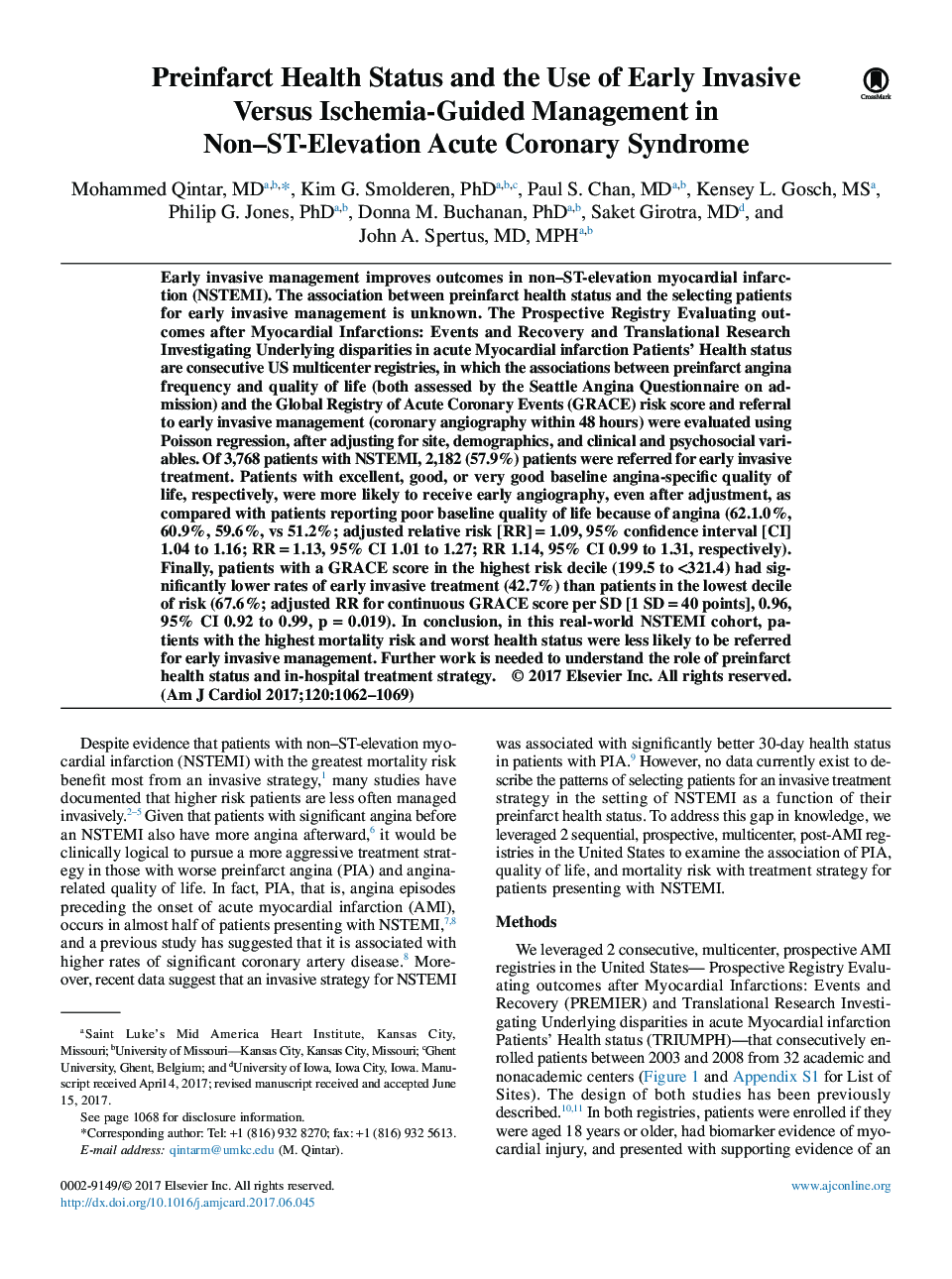| کد مقاله | کد نشریه | سال انتشار | مقاله انگلیسی | نسخه تمام متن |
|---|---|---|---|---|
| 5594674 | 1572077 | 2017 | 8 صفحه PDF | دانلود رایگان |
عنوان انگلیسی مقاله ISI
Preinfarct Health Status and the Use of Early Invasive Versus Ischemia-Guided Management in Non-ST-Elevation Acute Coronary Syndrome
ترجمه فارسی عنوان
وضعیت سلامتی قبل از تزریق و استفاده از مداخله درمانی اولیه در مقابل مدیریت اسکیزوفرنی در سندرم حاد کرونری بدون سکته قلبی
دانلود مقاله + سفارش ترجمه
دانلود مقاله ISI انگلیسی
رایگان برای ایرانیان
موضوعات مرتبط
علوم پزشکی و سلامت
پزشکی و دندانپزشکی
کاردیولوژی و پزشکی قلب و عروق
چکیده انگلیسی
Early invasive management improves outcomes in non-ST-elevation myocardial infarction (NSTEMI). The association between preinfarct health status and the selecting patients for early invasive management is unknown. The Prospective Registry Evaluating outcomes after Myocardial Infarctions: Events and Recovery and Translational Research Investigating Underlying disparities in acute Myocardial infarction Patients' Health status are consecutive US multicenter registries, in which the associations between preinfarct angina frequency and quality of life (both assessed by the Seattle Angina Questionnaire on admission) and the Global Registry of Acute Coronary Events (GRACE) risk score and referral to early invasive management (coronary angiography within 48 hours) were evaluated using Poisson regression, after adjusting for site, demographics, and clinical and psychosocial variables. Of 3,768 patients with NSTEMI, 2,182 (57.9%) patients were referred for early invasive treatment. Patients with excellent, good, or very good baseline angina-specific quality of life, respectively, were more likely to receive early angiography, even after adjustment, as compared with patients reporting poor baseline quality of life because of angina (62.1.0%, 60.9%, 59.6%, vs 51.2%; adjusted relative risk [RR]â=â1.09, 95% confidence interval [CI] 1.04 to 1.16; RRâ=â1.13, 95% CI 1.01 to 1.27; RR 1.14, 95% CI 0.99 to 1.31, respectively). Finally, patients with a GRACE score in the highest risk decile (199.5 to <321.4) had significantly lower rates of early invasive treatment (42.7%) than patients in the lowest decile of risk (67.6%; adjusted RR for continuous GRACE score per SD [1 SDâ=â40 points], 0.96, 95% CI 0.92 to 0.99, p = 0.019). In conclusion, in this real-world NSTEMI cohort, patients with the highest mortality risk and worst health status were less likely to be referred for early invasive management. Further work is needed to understand the role of preinfarct health status and in-hospital treatment strategy.
ناشر
Database: Elsevier - ScienceDirect (ساینس دایرکت)
Journal: The American Journal of Cardiology - Volume 120, Issue 7, 1 October 2017, Pages 1062-1069
Journal: The American Journal of Cardiology - Volume 120, Issue 7, 1 October 2017, Pages 1062-1069
نویسندگان
Mohammed MD, Kim G. PhD, Paul S. MD, Kensey L. MS, Philip G. PhD, Donna M. PhD, Saket MD, John A. MD, MPH,
